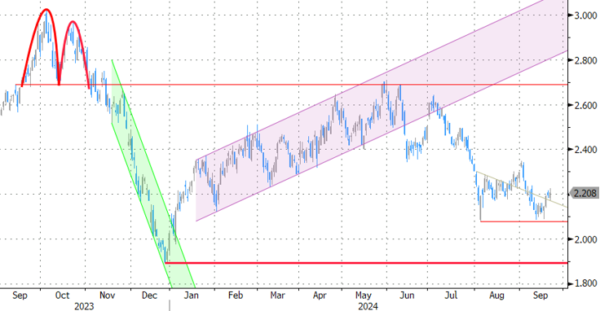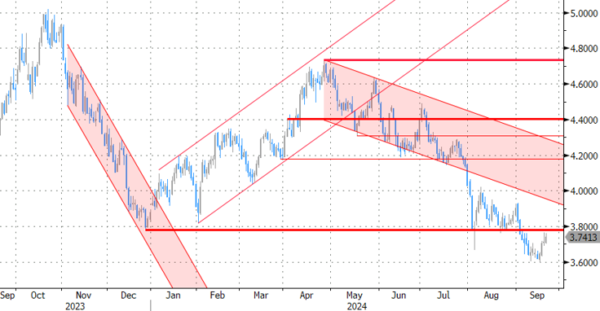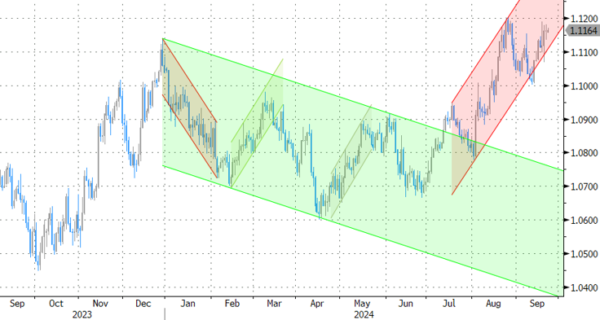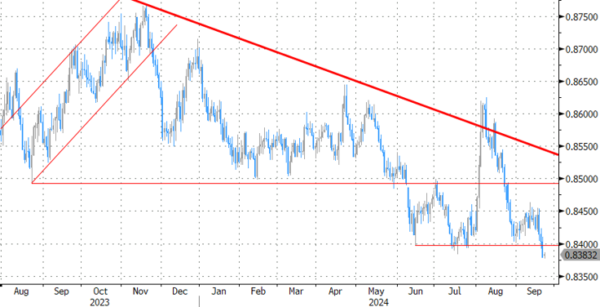Markets
Sterling was among the outperformers on currency markets last Friday. The British pound excelled on significantly stronger than expected August retail sales after an already bumper July. EUR/GBP’s downside at 0.838 (July and by extension a two-year low) is cracking. GBP/USD topped the 1.33 big figure for the first time since February 2022. It attacked the 1.3328 resistance level (76.4% recovery on the 2021-2022 decline). A break higher looks likely on GBP strength and/or USD weakness. Fed’s Waller triggered some of the latter in late European dealings. The influential policymaker said he supported a 50 bps cut last week on favourable inflation dynamics rather than concerns over the labour market. He would do so again in November if the price evolution were to surprise again or if labor market data worsens. That’s setting the bar low and markets noticed. An intraday U-turn in US yields steepened the curve with the front adding less than 1 bp (vs gains of >6 bps earlier on the day) and the long end rising 3.3 bps. Fed fund futures’ pricing now implies a 51% chance of another 50 bps November 7. German yields moved between 0.8 and 1.3 bps higher. ECB’s Lagarde unveiled some of the scope of its strategic review that follows the one that ended in 2021 in a speech at the IMF on Friday. This one will be less wide-ranging and the 2% target isn’t up for discussion. It’s an exercise that focuses on how to deal with risks and uncertainty in an era of more volatile inflation and as structural shifts unfold. It “provides an opportunity to consider how to balance the information from baseline forecasts with real-time information, how to make best use of alternative scenarios, and the importance of the medium-term orientation when faced with different types of shocks.” The results will be published in the second half of 2025.
A quiet Asian sessions brings us quickly to the European eco calendar for today. PMI’s are scheduled for release. The European September gauge is expected to remain near the August levels, meaning: a still-contracting manufacturing sector (45.7 from 45.8), a modestly expanding services sector (52.3 from 52.9) and shy economic growth overall (50.5 composite, down from 51). Risks, if any, are tilted to the downside with the French Olympic boost now dropping out of the equation. That could slow or halt the dollar-driven ascent of EUR/USD, especially with the first important resistance levels nearby (EUR/USD 1.1202). The European/German yield curve is most vulnerable at the front but a negative surprise would drag the longer end probably down as well. First support in the German 10-yr kicks in at 2.08%. 2.34% is the parallel reference of the 10-yr swap.
News & Views
Rating agency Fitch on Friday upwardly revised Portugal’s credit rating outlook from stable to positive while affirming the rating itself at A-. The positive outlook reflects continued progress in reducing public debt, a record of and commitment to prudent fiscal policy and an ongoing external deleveraging. Fitch for 2024 expects moderate economic growth and modest budget surplus (0.2%) to reduce government debt to 95.8% of GDP (from 99.1% at end 2023). It expects a further decline in the debt to GDP ratio to 82.5% by 2028. This projection is underpinned by a high primary surpluses and sustained growth. Fiscal outperformance is seen to continue relative to its rated peers and most EU countries. It sees a budget deficit of 0.2% in 2025-26. Portugal’s debt profile is also supported by substantial cash buffers and a high proportion fixed rate debt. The rating agency thinks the country’s external deleveraging will continue with the current account to expected to stay in surplus (1.7% this year, 1.6% in 2025 and 1.5% in 2026).
The People’s Bank of China provided 160.1 bn yuan of liquidity via 7-reverse repos at 1.7% and 74.5 bn yuan via a 14-day repo at 1.85%. The latter compares to a level of 1.95% at a previous operation. China often uses the 14 day repo to provide liquidity to the banking system ahead of a period of prologued holidays. Even so, the reduction in the rate might be an indication of the PBOC’s intention to further ease policy as economic activity continues to disappoint. Markets are looking forward to a joined press conference scheduled for tomorrow by the heads of the PBOC, the National Financial regulatory Administration and the Chine Securities Regulatory Commission. At the press conference the PBOC and other authorities are expected to address financial support for the economy. The yuan this morning is holding its recent gains against a broadly weak dollar with USD/CNY trading near 7.047.
Graphs
GE 10y yield
The ECB cut policy rates by 25 bps in June and in September. Stubborn inflation (core, services) make follow-up moves less evident. We expect the central bank to stick with the quarterly reduction pace. Disappointing US and unconvincing EMU activity data dragged the long end of the curve down. The move accelerated during the early August market meltdown.
US 10y yield
The Fed kicked off its easing cycle with a 50 bps move. It is headed towards a neutral stance now that inflation and employment risks are in balance. Conservative SEP unemployment forecasts risk being caught up by reality and with it the dot plot (50 bps more cuts in 2024). We hold our call for two more 50 bps cuts this year. Pressure on the front of the curve and weakening eco data keeps the long end in the defensive for now as well.
EUR/USD
EUR/USD moved above the 1.09 resistance area as the dollar lost interest rate support at stealth pace. US recession risks and bets on fast and large rate cuts trumped traditional safe haven flows into USD. EUR/USD 1.1276 (2023 top) serves as next technical references.
EUR/GBP
The BoE delivered a hawkish cut in August. Policy restrictiveness will be further unwound gradually on a pace determined by a broad range of data. The strategy similar to the ECB’s balances out EUR/GBP in a monetary perspective. Recent better UK activity data and a cautious assessment of BoE’s Bailey at Jackson Hole are pushing EUR/GBP lower in the 0.84/0.086 range.


















